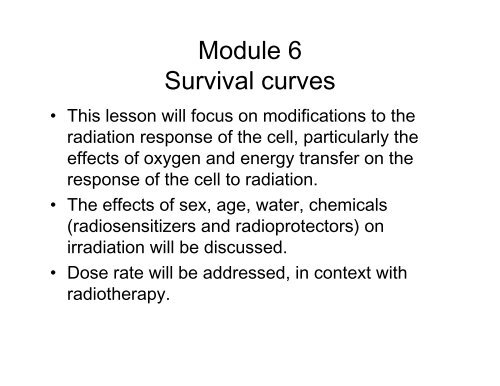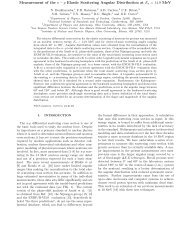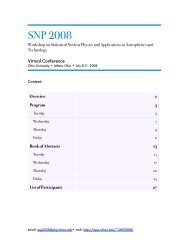Module 6 Survival curves
Module 6 Survival curves
Module 6 Survival curves
- No tags were found...
Create successful ePaper yourself
Turn your PDF publications into a flip-book with our unique Google optimized e-Paper software.
<strong>Module</strong> 6<strong>Survival</strong> <strong>curves</strong>• This lesson will focus on modifications to theradiation response of the cell, particularly theeffects of oxygen and energy transfer on theresponse of the cell to radiation.• The effects of sex, age, water, chemicals(radiosensitizers and radioprotectors) onirradiation will be discussed.• Dose rate will be addressed, in context withradiotherapy.
Dose-Response Curves• Several clonogenic assays can determine dose-responserelationships for cells of normal tissues. The assays for skin colony,testes, kidney tubule, and jejunum crypts can determine thereproductive integrity of individual cells. Bone marrow cells, thyroidcells, and mammary cells all involve transplantation into another site.Skin reactions in pigs, lung response in mice, and spinal corddamage can be used to determine functional endpoints for doseresponse<strong>curves</strong>.• In general, the response of a tissue or organ to radiation depends ontwo factors: (1) inherent sensitivity of the individual cells, and (2)kinetics of the population as a whole of which the cells are a part.• In highly-differentiated tissues that have specialized functions, thecell survival <strong>curves</strong> are irrelevant due to the lack of mitotic future ofthe cells. The radiation needed to destroy the function of the cell ismuch greater than that to stop mitosis of the cell.
<strong>Survival</strong> Curves• The survival <strong>curves</strong> of mammalian cells can be used toobtain direct information on their response to radiation.• When the logarithm of a typical cell survival is plottedversus dose on a linear scale, several features becomeevident. At larger doses of radiation, the graph becomesa straight line on this scale. At low doses, a shoulder onthe curve is found, which is quantified by the thresholddose. The width of shoulder of the survival curveindicates the degree of sublethal damage, which is morereadily repaired in the S phase.
D m , D 0 , D q• The mean lethal dose, D m , is defined as that amount of radiationrequired to reduce the survival by 37%. It is equal to D 37 in the linearportion of the curve. A large D m indicates a radioresistant line ofcells, whereas a small D m is characteristic of cells with a highradiosensitivity.• The D 0 is the slope of the exponential portion of the curve, whichis the nonlethal dose. The threshold dose, D q , is a measure of howmuch damage occurs before it is lethal. The D q is a measure of thewidth of the shoulder. A large D q indicates that a cell can readilyrecover.• The D 0 value is the measure of intrinsic radiosensitivity of a cell type,whereas the clinical radiosensitivity depends upon the size of theshoulder and the cellular environment.
Quasithreshold, D q• The shoulder of the survival curve isexplained in various theories:o According to the target theory, the shoulder isdue to the interaction of sublethal lesions.o The repair model assumes the shoulder isdue to the repair of single lesions produced bysingle tracks of radiation in proportion to dose,a mechanism which may become saturated.
Application of <strong>Survival</strong> Curves• The existence of a threshold in cell-survival <strong>curves</strong>implies that some damage must accumulate before it isfatal to the cell.• The larger the value of D q , the more damage that mustaccumulate before reproductive death. This damage tocells prior to cell death is called sublethal damage.• In radiation therapy it is very important to note that whena dose is split into two parts separated by enough time, athreshold is observed for each part of the dose. Thus byproperly spacing treatment, it is possible to reduce thedamage to healthy cells during radiation treatment. Thisconcept of dose fractionation will be further exploredlater in this lesson.
Delay in doseA = ContinuousB = 30 minutesC = 2 hoursD = 6 hours
Types of Radiation Damage• Non-lethal damage involves a lesion which does not prevent proliferation, but itaffects the rate of such proliferation.• Lethal damage is damage which is irreparable, irreversible, and leads irrevocablyto cell death.• Sublethal damage is damage which is repaired in hours unless additional sublethaldamage is added, with which it interacts to form lethal damage. Basically,sublethal damage, which is chiefly evident at low dose levels, is shed after thepassage of a relatively short period of time. It has been shown that the repair ofsublethal damage reflects the repair and the rejoining interval of double strandbreaks before they can interact to form lethal lesions.• Potentially lethal damage is the damage that can be modified by postirradiationenvironmental conditions. This type of damage is manifest in those cellpopulations which are proliferating and are well nourished. This type of damage isonly lethal if cells are stimulated to divide before repair occurs. Therefore, ifmitosis can be delayed by suboptimal growth conditions, the DNA damage can berepaired. Potentially lethal damage limits the effectiveness of radiotherapy ontumors. There is no potentially lethal damage repair following exposure to highlinear energy transfer radiations.
Cell Cycle Effects• During the cell cycle the radiation sensitivity ofthe cells can change dramatically. Studies usingcells which have their cell cycles synchronizedhave shown the results.• The mitosis phase, where the cell divides, isalways the most sensitive, while late in the Sphase, where DNA synthesis occurs, is the leastsensitive. This knowledge is useful in theplanning of cancer treatments.
The Effect of Oxygen and LET onCell <strong>Survival</strong>• The most biologically variable factor thatmodifies the radiation response is the amount ofoxygen in the system.• A measure of the effect of oxygen is OER(oxygen enhancement ratio) which is defined bythe equation:OER = D 0 (anoxic)/ D 0 (oxygenated)where D 0 (anoxic) is the dose required to producethe same effect as D 0 (oxygenated), the dose inthe oxygenated system.
Chemical Effects on Dammage
Oxygen Effect in Tumors• This section will illustrate the practical importance of the oxygen effect inradiotherapy. The presence of a relatively small proportion of hypoxic cellsin tumors can limit the success of radiotherapy. Tumors consist of twopopulations of cells—one well-oxygenated fraction and the hypoxic fraction,which may account for 10-15% of a human tumor. As the tumor isirradiated, the radiation will kill the more radiosensitive outer cells but notthe more radioresistant, oxygen-deprived inner cells. As a result, there willbe an increase in the supply of nutrients to these inner cells, which willagain start proliferating if they have retained their reproductive potential.Therefore, though these cells are only a small fraction of the tumor, theyplay an important role in the radioresponsiveness of a tumor. Administrationof hyperbaric oxygen is used to ensure the radiosensitivity of the tumor.Hyperbaric oxygen administration increases the success rates ofradiotherapy for head and neck tumors.• <strong>Survival</strong> <strong>curves</strong> are biphasic for tumors, with a steep initial slope for thewell-oxygenated proportion of the tumor cell population and a shallower finalcurve over the higher doses where the radioresistant hypoxic cellspredominate. Overall, the most sensitive tumors have much less than 1%hypoxic cells, whereas resistant tumors have more than 10% hypoxic cells.
Calculation of OxygenEnhancement RatioOER = D 0 (anoxic)/D 0 (oxegenated)
Linear Energy Transfer• The amount of energy deposited per unit distance is known as linearenergy transfer or LET. LET is only an average quantity.• As the LET increases, the relative biological effectiveness (RBE)increases slowly at first, and then more rapidly as the LET increasesbeyond 10 KeV/µm.• This value probably reflects the "target size" and is related to DNAcontent (the diameter of the DNA double helix). Radiation of thisdensity is most likely to cause double strand breaks.• High LET produces damaging effects through double strand breaks.Low LET radiation produces most of its damage by interaction of twosublethal events. There is little or no shoulder on the survival curvefor high LET radiation.
Difference of Tract Properties
Relative Biological Effectiveness• RBE = D 0 (standard radiation)/ D 0 (testradiation)where D 0 (standard radiation) is the dose ofstandard radiation required to produce the sameeffect as the dose of a test radiation, D 0 (testradiation). The standard radiation is due to x-rays and gamma rays. As has been describedpreviously, RBE is dependent on both theradiation and the LET.
Relative Biological EffectivenessDependencies• radiation dose• number of dose fractions• dose rate• biological system or endpoint
Dose Rate—Protraction• Cellular sensitivity of the stem cellsinvolved.• Duration of the cell cycle (i.e., moredamage to cells with a long cell cycle).• Ability of some tissues to adapt to thenew trauma of continual radiation.
Dose Rate—Fractionation• The goal of fractionation in radiotherapy is to kill alltumor cells without producing serious damage to thenormal surrounding tissues.• This is best achieved by giving the total dose of radiationin a specific number of fractions over a time period,generally five treatments a week for six weeks.• Repair, reassortment, repopulation, and reoxygenation,the four Rs of radiotherapy, determine the effectivenessof the fractionation.• Fractions also increase damage to a tumor because ofreoxygenation and reassortment of cells intoradiosensitive phases of the cycle
Four R’s of Radiobiology• In radiotherapy, these types of cellular damage are regulated by thefour R’s of radiotherapy. The four Rs of radiobiology—repair,reassortment, repopulation, and reoxygenation—are affected by thetype of radiation dose.• There is a prompt repair of sublethal repair damage.• There is a progression of cells through the cell cycle during theinterval between the split doses, called reassortment.• There is an increase of surviving fraction due to cell division, orrepopulation. When the time interval between two dose fractionsexceeds the cell cycle, there will be an increase in the number ofcells surviving due to cell proliferation.• The fractionation of the dose allows greater affect throughreoxygenation of the tumour, which increases the radiosensitivity.
Summary• The survival <strong>curves</strong>, which illustrate the survival of a population ofcells, can show the effects of factors such as sex, age, and doserate.• Graphing a survival curve gives a great deal of pertinent informationsuch as threshold dose and mean lethal dose.• Oxygen has an important influence on the effects of radiation due todestruction of the cell by a free radical.• The effects of radiation are influenced by cell cycle position, water,linear energy transfer, age, sex, chemicals, and temperature.• The effects of dose rate on radiation is important for therapeuticradiation use.• Radiosensitizers and radioprotectors are limited in their use due totoxicity.








